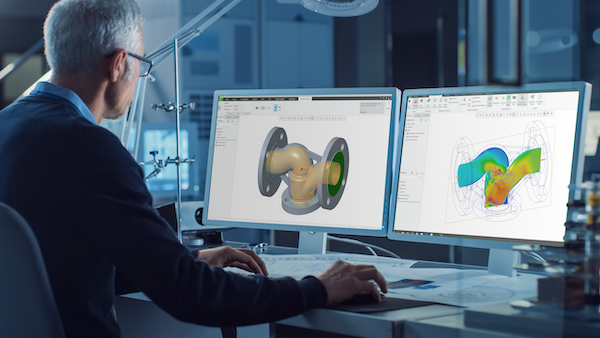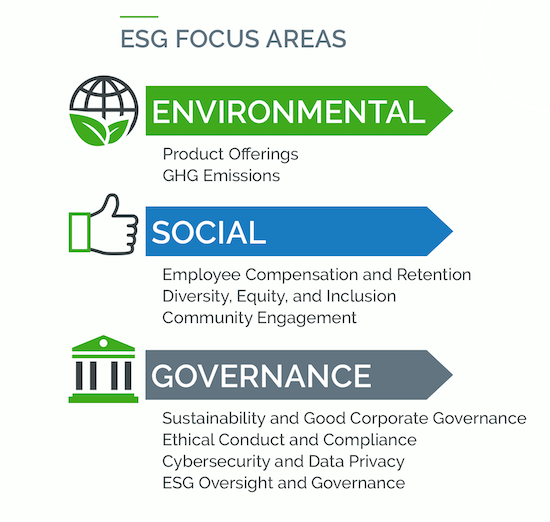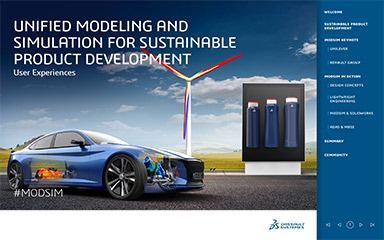Ready or Not, Manufacturers will Soon be Held to Rigid Sustainability Standards
By enabling manufacturers to incorporate sustainability best practices into the early upstream product development stages, engineers can advance innovation while helping to mitigate the industry’s environmental footprint.

Image courtesy of PTC.
Latest News
April 27, 2024
According to the United States Census Bureau, data from the International Database puts the global population at about 8 billion and rising. With this growth comes an increased demand for products. Unfortunately, as manufacturing output intensifies, so does its effect on the environment.
Common significant environmental footprints in discrete manufacturing include:
- Material Consumption: The current demand alone exceeds 1.75 of Earth’s capacity.
- Energy Consumption: 54% of global energy consumption is by manufacturing and production sectors.
- Waste (Hazardous and Non-Hazardous): Only 18% of e-waste and 6% of discarded plastic is recycled. Although aluminum can be infinitely recycled, 7 million tons are not recycled each year.
In response, forward-thinking manufacturers are emphasizing a shift towards more sustainable practices. In addition to social awareness, such initiatives are generally driven by a confluence of business factors, including demand, regulatory requirements, economic benefits, and the broader shift towards a circular economy.
Corporate Initiatives
At the highest level, ecological stewardship has many benefits. Such programs are shown to lower costs, align the organization with current and impending regulations, and create a positive mindshare among eco-conscious consumers.
Regulations
Adopting sustainability initiatives is not only a choice for responsible business but also a necessity to remain compliant with evolving legal frameworks. Strict environmental requirements are in place throughout much of the world. And the International Sustainability Standards Board (ISSB) is rapidly consolidating standards frameworks and gaining international adoption. Aligned with this standard is the European Corporate Sustainability Reporting Directive (CSRD) which directs manufacturers to measure and reduce a product’s carbon footprints. The initiative affects 50,000 global companies including all exporters to the European Union.
Similar mandates will soon be a part of normal business operations as local governments and international organizations are enacting policies and regulations aimed at reducing carbon emissions, minimizing waste, and promoting environmentally friendly manufacturing processes. Failure to comply may result in legal consequences, fines, or restrictions on operations.
Good for Business
Today’s consumers are well informed and frequently motivated by social issues. What’s more, they understand the impact of buying decisions. As a result, brands that align with sustainable practices often enjoy enhanced customer loyalty and a positive reputation.
In a recent survey published in Sustainable Brands, 75% of responders said that they are concerned about the environmental impact of the products they purchase. And 66% said that despite today’s high inflation, they were willing to pay more for sustainable products.
Additional findings include:
- 60% are more likely to buy stock in a company that is perceived as sustainable, versus one that is not.
- 69% say a product’s environmental impact is important to their purchasing decision.
- 70% agree that climate events have made them more likely to seek out more sustainable products. Of this group, 38% had not previously purchased such products.
- 73% would sign up for a company’s voluntary rewards or loyalty program if it helped reduce the environmental impact of their purchases.
Finally, implementing sustainability practices not only minimizes risks but also secures contracts. To help minimize its environmental impact, manufacturers are scrutinizing supply chains to measure, validate, and monitor compliance and hold suppliers accountable.
Cost Savings
Most scalable sustainable practices lead to measurable cost savings through improved resource efficiency, waste reduction, and energy conservation. By optimizing production processes, manufacturers can minimize resource inputs, lower production costs, and enhance overall operational efficiency. Additionally, investing in renewable energy sources and energy-efficient technologies can contribute to long-term cost reductions and insulate manufacturers from volatile energy prices.
Supply chain resilience underscores the importance of sustainability in manufacturing. As climate change and environmental issues pose risks to global supply chains, manufacturers are recognizing the need to build resilience by adopting sustainable practices. This involves assessing and mitigating the environmental and social risks associated with sourcing raw materials, transportation, and other supply chain elements.
A Circular / Modular Economy
Sustainability initiatives contribute to the overarching goal of achieving a circular or modular economy. This shift minimizes waste, maximizes a product’s lifespan, and promotes recycling and reuse.
Manufacturers can mitigate their environmental footprint by developing products with reuse and recyclability in mind, using recycled materials, and establishing take-back programs. This not only reduces the environmental impact but also opens new business opportunities and revenue streams.
Challenges
Despite its benefits and impending mandates, sustainability remains a secondary consideration for many manufacturers as balancing economic viability and implementation with environmental responsibility can be a struggle. Energy consumption poses a significant hurdle, as manufacturers often rely on non-renewable sources.
Waste management demands innovative solutions to reduce landfill reliance and promote recycling. What’s more, supply chain sustainability, including ethical sourcing and transportation emissions, and regulatory pressures to comply with environmental standards compound these challenges. Still, others believe that such initiatives require a drastic and costly overhaul of current tools and processes.
Adopting sustainability demands holistic strategies integrating technology, process optimization, and stakeholder engagement. At the same time, to feed this growing trend, technology providers must continually strive to develop the tools and supporting services to make implementation effective, practical, and non-disruptive.
The good news is that sustainability is gaining traction among manufacturers and product development organizations. A recent survey of PTC users found that about 20% reported sustainability to be a primary factor in design. And that number continues to grow.
Sustainable Product Development
Because 80% of a product’s carbon footprint is determined in the upstream design stage, decisions here ripple throughout the extended enterprise. Design engineers must have an eco-centered view of the product lifecycle. Increasingly, this means balancing cost, performance, risk, time-to-market, manufacturability, serviceability, and sustainability.
Today, PTC provides the tools to incorporate sustainability into mainstream product development. According to the company’s Vice President of Sustainability, David Duncan, this push was initiated by growing requests from its customer base.
“For most discrete products, only about 10% of its carbon footprint comes from the factory; while 90% is traced to the supply chain,” said Duncan. “Because of this, manufacturers are asking for visibility into their suppliers’ environmental footprint along with firm commitments to reduce their carbon buildup.”
According to Duncan, PTC helps manufacturers advance sustainability and leverage its benefits by proactively addressing a product’s composition, manufacturing, and disposal – all in the initial upstream product design stage.
“This is where CAD (Computer-Aided Design) can make a significant impact. CAD is exceptional at dematerialization, that is, finding better material and using less of it. It can also identify a manufacturing process that is not only energy efficient but also reduces unrecoverable waste – by minimizing scrap for example.”
Sustainable Product Design
Robust design tools are empowering product designers with a greater opportunity to ensure sustainability from cradle to grave. This includes material selection, dematerialization, product validation, and manufacturing process optimization.
Design for Sustainability (DfS) is a comprehensive design approach giving equal consideration to a product’s form, function, and environmental impact. It focuses on resource efficiency and the use of eco-friendly materials to develop products and processes.
DfS may include light weighting, part consolidation, additive manufacturing, design for modularity and longevity, simplifying designs to reduce the number of parts, and standardizing parts for widespread use. Additionally, substituting the construction, testing, and disposal of multiple physical prototypes with more widespread use of simulation reduces the number of prototypes needed to validate the design. This not only accelerates development but reduces waste.
Best addressed at the component level, DfS is centered on:
- Selecting low impact materials
- Reducing material usage
- Selecting efficient and responsible part manufacturing methods
- Ensuring part recycling and remanufacturing
Duncan explains that PTC’s evolving Environmental, Social and Governance (ESG) initiatives are helping to make the company a trusted technology partner and a responsible steward of the planet.
This is demonstrated through a commitment to near-term emissions reductions and long-term net-zero targets, as well as providing software to support the sustainability targets of its manufacturing customers.

“Our position is that product sustainability improvements scale faster when correlated to financial benefits,” Duncan said. “Our solutions allow manufacturers to design, produce, and service products more efficiently and sustainably. We’re committed to assisting our customers in achieving their long-term sustainability goals while providing innovative solutions that drive market share.”
These technologies support sustainable product development objectives by providing a cradle-to-grave eco-design approach to product design and manufacturing. The results are longer-lasting products, lower C02 emissions, and less waste.

Design for Sustainable Manufacturing (DfSM) promotes the use of renewable resources, reducing energy consumption, and minimizing generated waste throughout the manufacturing process. Eco-friendly materials, production processes, recyclability, biodegradability, and longevity are all emphasized. Similarly, DSM prioritizes efficiency and resource conservation, decreases carbon emissions, and other forms of pollution.
Design for Assembly (DfA) reduces the number of product components and minimizes required assembly operations. This makes the manufacturing process more efficient and productive while advancing sustainability.
Scrutinizing each part in an assembly will help to determine if that part should be combined with another part. In doing this the designer may ask:
- How does the part operate relative to other parts in the assembly?
- Does the part contain a different material for aesthetic or functional reasons?
- Must the part be separate to: properly function, provide access to other parts, allow for repair and maintenance?
Design for Disassembly (DfD) considers in the early upstream stage how to minimize the environmental impact of a product through reuse, repair, remanufacture, and recycling. This involves determining how the product will be managed at the end of its useful life and includes disassembly along with the recovery (or disposal) of its materials and components.
Sustainability in Action
Today environmentally responsible organizations are taking action. By leveraging technologies such as Generative Design and Additive Manufacturing, companies like Jacobs Engineering, HPE COXA, and more are optimizing parts, slashing weight and reducing materials. All of which contributes to sustainability as well as the bottom line.
Cummins Engine: Revving Up Sustainability
Cummins Engine is the world’s largest independent diesel and gas engine designer and manufacturer and a leading supplier of electrification systems, including fuel cells and battery systems. As an energy-producing business, Cummins has long made it a company goal to reduce their environmental impact.
The company’s sustainability program, PLANET 2050, includes quantifiable near-term goals for 2030 as well as long-term aspirations dating out to 2050.
“We’re taking very seriously the amount of material that we put into our new designs and the amount of water that is required to manufacture them,” said David Genter, Director of Design Engineering at Cummins. “Given that most of the CO2 footprint is determined within an item’s design phase, if you don’t utilize generative, or if you choose a suboptimal material that can’t be recycled, reused, or remanufactured, that ship sails very early in the whole design and development process.”
With a goal to reduce material usage by 10% to 15%, the company is working to fully integrate emerging technologies into their design process. As part of the Circular Lifecyle Plan for Every Part, Cummins provides written documentation that they’ve chosen the best material specification and process; that they applied material optimization techniques, such as generative design; and that they devised a recycling, remanufacturing, and reuse plan for every newly designed component.
PTC’s Simulation-Driven Design solution is essential to this strategy. Cummins is taking a critical step toward achieving their sustainability goals by implementing a Circular Lifecycle Plan for every part they design. Optimizing a component to minimize material-use is now a basic expectation for the part they design, and formally woven into their Corporate Design Review standards to support meeting their sustainability goals.
Read the entire case study here.
What’s Ahead
PTC is developing sustainability solutions for today and beyond. The immediate focus is on optimizing manufactured products. That is, allowing the designer to utilize better material through material database integrations, using less of that material through CAD design techniques such as generative design, lattice structure, simulations, and identifying eco-friendly manufacturing processes through manufacturing simulation.
Longer term, Duncan cites circular design and modular design as becoming increasingly important to the industry, planet, and PTC.
“In a linear or recycling process, parts are melted down or shredded and then the manufacturing process is repeated. Processing the material and manufacturing the new product consumes energy and creates some waste. The better option would be parts that can be repaired, reused, remanufactured, or refurbished. We’ve found that remanufactured or refurbished products are often 80% to 90% more carbon efficient than a virgin resourced product.”
Steps toward a Healthier Planet
The movement to globally mandate sustainability is no longer a question of if but when; and manufacturers are taking steps to actively demonstrate ecological and social leadership. Moreover, sustainability is a strategic decision, and manufacturers who embrace its practices will position themselves as market leaders in an increasingly eco-conscious marketplace.
As a result, enabling tools from technology providers is nothing short of critical.
“The bottom line is, sustainability is only sustainable when it aligns with product targets, contributes to financial goals, and is seamlessly embedded into existing workflows,” Duncan concludes. “Software developers have an equal stake in securing our planet’s future. Responsible product development processes must be driven by robust yet practical solutions. Only then will we see results that are significant, measurable, and lasting.”
Robert Farrell is president of Farrell Marcom, LLC and a co-founder of Revolution in Simulation (Rev-Sim.Org).
More PTC Coverage
Subscribe to our FREE magazine, FREE email newsletters or both!
Latest News







